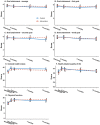Bridging gaps across levels of care in rehabilitation of patients with rheumatic and musculoskeletal diseases: Results from a stepped-wedge cluster randomized controlled trial
- PMID: 36862585
- PMCID: PMC10387727
- DOI: 10.1177/02692155231153341
Bridging gaps across levels of care in rehabilitation of patients with rheumatic and musculoskeletal diseases: Results from a stepped-wedge cluster randomized controlled trial
Abstract
Objective: To compare the effectiveness of a structured goal-setting and tailored follow-up rehabilitation intervention with existing rehabilitation in patients with rheumatic and musculoskeletal diseases.
Design: A pragmatic stepped-wedge cluster randomized trial.
Setting: Eight rehabilitation centers in secondary healthcare, Norway.
Participants: A total of 374 adults with rheumatic and musculoskeletal diseases were included in either the experimental (168) or the control group (206).
Interventions: A new rehabilitation intervention which comprised structured goal setting, action planning, motivational interviewing, digital self-monitoring of goal progress, and individual follow-up support after discharge according to patients' needs and available resources in primary healthcare (the BRIDGE-intervention), was compared to usual care.
Main measures: Patient-reported outcomes were collected electronically on admission and discharge from rehabilitation, and after 2, 7, and 12 months. The primary outcome was patients' goal attainment measured by the Patient Specific Functional Scale (0-10, 10 best) at 7 months. Secondary outcome measures included physical function (30-s Sit-To-Stand test), health-related quality of life (EQ-5D-5L-index), and self-assessed health (EQ-VAS). The main statistical analyses were performed on an intention-to-treat basis using linear mixed models.
Results: No significant treatment effects of the BRIDGE-intervention were found for either primary (Patient Specific Functional Scale mean difference 0.1 [95% CI: -0.5, 0.8], p = 0.70), or secondary outcomes 7 months after rehabilitation.
Conclusion: The BRIDGE-intervention was not shown to be more effective than existing rehabilitation for patients with rheumatic and musculoskeletal diseases. There is still a need for more knowledge about factors that can improve the quality, continuity, and long-term health effects of rehabilitation for this patient group.
Keywords: Rheumatic and musculoskeletal diseases; complex interventions; goal setting; health behavior change; motivational interviewing; multidisciplinary rehabilitation; patient-centered; quality of life; stepped-wedge cluster randomized trial; supportive follow-up.
Conflict of interest statement
The author(s) declared no potential conflicts of interest with respect to the research, authorship, and/or publication of this article.
Figures


References
-
- Briggs AM, Cross MJ, Hoy DG, et al. Musculoskeletal health conditions represent a global threat to healthy aging: a report for the 2015 World Health Organization world report on ageing and health. Gerontologist 2016; 56: S243–S255. - PubMed
-
- Gutenbrunner CW AB, Chamberlain AM. White book on physical and rehabilitation medicine in Europe. J Rehabil Med 2007 (Revised November 2009); 39: 48.
Publication types
MeSH terms
LinkOut - more resources
Full Text Sources

